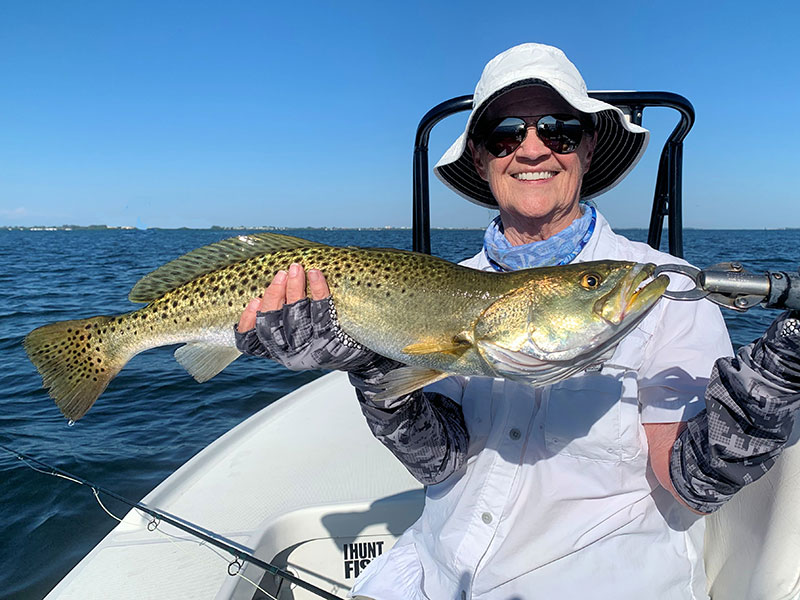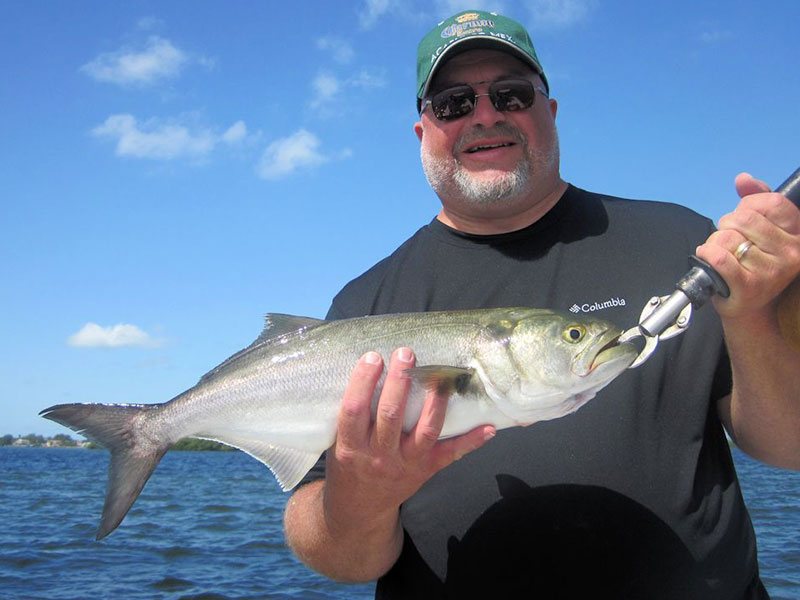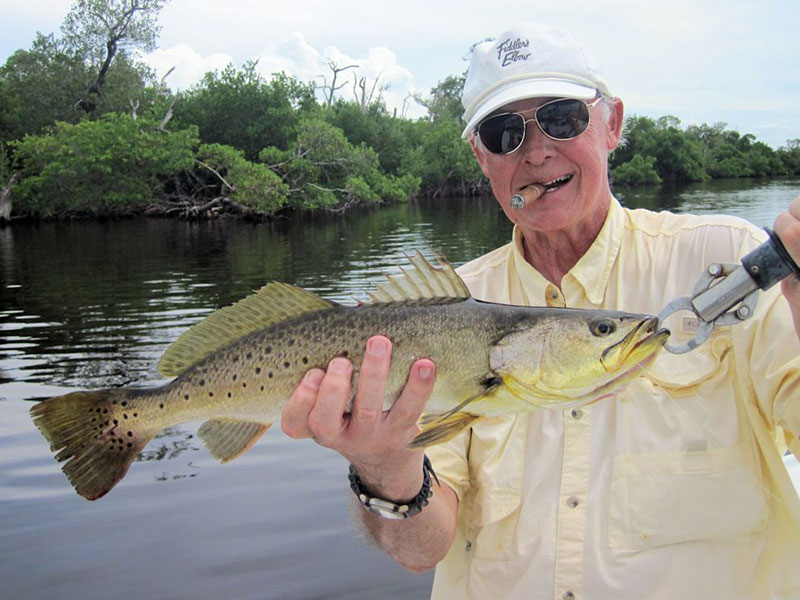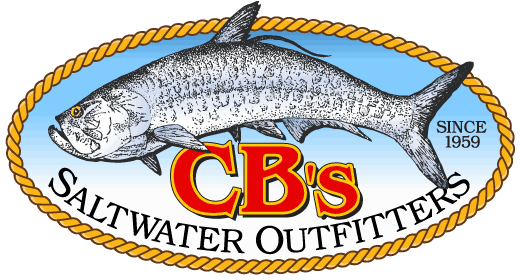September is one of my favorite months. Reds should be schooling on shallow grass flats and you also might find big trout there at first light. Baitfish along beaches will attract Spanish mackerel, false albacore (little tunny), sharks, tarpon and more. You should find snook around docks and bridges in the ICW.
There should also be tarpon around bridges at night and in areas of Tampa Bay and Charlotte Harbor. Juvenile tarpon from 10 to 30-pounds should be a good option in creeks and canals.
Tarpon should still be a good option this month. Many have moved to inside waters, so you’ll find them around bridges, over deep grass flats or deeper areas. When tarpon move into these areas, they are in a feeding mode. After a long migration and with their spawning duties completed, they need to rest and eat to restore themselves. Ladyfish will feed in glass minnow schools and tarpon will gorge themselves on ladyfish.
I have also seen tarpon, “ball” glass minnows into tight schools, and eat them by the bucket full! Fly anglers should score with wide profile patterns, such as Lefty’s Deceiver or EP flies. Small flies, like my Grassett Snook Minnow, tied on a 1/0 or 2/0 hook, are a good choice for tarpon that are feeding on glass minnows.
You should find snook this month around docks and bridges close to passes. They will also start making their move towards shallow flats where you might find them staging along sand bars or in potholes. Fly poppers or Gurglers may draw some big strikes in shallow water at night or early in the day! I often fish lighted docks and bridges for snook before dawn before moving to the flats after daylight. My Grassett Snook Minnow fly is my ‘go to” fly pattern for snook at night.
Reds are usually in large schools in September. You may find them in shallow water when the tide is high or along the edges of flats when the tide is low. Look for wakes, some as big as boat wakes, or “pushes” to locate them. If it is calm, a school of reds may look like a nervous patch of water or if there’s a ripple on the surface, the school may appear as a slick patch of water. Once you’ve located them, try to get in front of them and work around the edges of the school to avoid spooking the whole school. Fly anglers should score with fly poppers, Gurglers and wide profile baitfish fly patterns.
I like to be as quiet as possible in shallow water, using a push pole to move my boat. It is great to find a big school of reds but remember, if you spook one fish you may spook the whole school. Running an outboard may make fish show themselves, but in the long run it will make them harder to catch. I sometimes also find big jacks and blues mixed with schools of big reds in shallow water. Not a bad problem!
Spotted trout fishing should also be good this month. Regulations have changed with a 3 fish per person, bag limit and a 6 fish boat limit. Trout must be from 15”-19” with one allowed per vessel over 19”. In my opinion it’s important to protect larger trout, which are usually female breeders. Full regulations and details on trout and other species can be viewed at https://myfwc.com/ . Look for big trout in skinny water in many of the same places that you find reds this month.
They will be most active in low light, either first thing in the morning or at dusk, particularly if we’ve had an afternoon shower. Cloud cover in the afternoon will also reduce heating of shallow flats, which usually makes fish more active. The same flies that you use for reds will work well for big trout in shallow water.
You may also find trout mixed with blues, pompano, Spanish mackerel, flounder and more on deep grass flats. I like to drift and cast quartering ahead of my drift. Fly anglers should do well with an Ultra Hair Clouser fly fished on a clear intermediate sink tip. In addition to making a series of drifts to find fish, focus on bait schools, breaking fish or diving birds to find fish. You may find tripletail on buoys, crab trap floats or channel markers in inside waters this month. A lightly weighted fly with a weed guard, like my Grassett Flats Minnow, works well for me. The weed guard is important to help prevent snagging crab trap lines.
You may also find tripletail along with cobia, false albacore (little tunny) and Spanish mackerel in the coastal gulf this month. Look for surface activity to find the mackerel and albies and cast small white flies to them. Look for feeding frenzies that begin with ladyfish feeding in glass minnow schools and may end with everything else, including sharks or tarpon, joining the fray. Remember to “match the hatch” to be successful. You may need to add wire to your tippet when toothy fish are around.
While you are looking for mackerel and albies in the coastal gulf, you can look for tripletail and cobia. Since stone crab traps haven’t hit the water yet this season, there are less places for them to be, so in addition to abandoned crab trap floats, check channel markers, buoys and any floating debris. Artificial reefs are another good area to check. Wide profile flies should be good choices for cobia for fly anglers and most tarpon flies will also work well for cobia.
There are lots of options this month, but the key is usually to fish early for the best chance at success. An early start for snook or tarpon around lighted docks or bridges and then on to the flats for reds, trout and more is a good plan. There should also be good action in the coastal gulf for a variety of species. I usually tarpon fish as long as I can, wherever I find them!
Our natural resources are under constant pressure from red tides fueled by residential, agricultural and industrial runoff, toxic spills and discharges, freezes, increasing fishing pressure and habitat loss and degradation, please limit your kill, don’t kill your limit!
September is one of my favorite months. Reds should be schooling on shallow grass flats and you also might find big trout there at first light. Baitfish along beaches will attract Spanish mackerel, false albacore (little tunny), sharks, tarpon and more. You should find snook around docks and bridges in the ICW.
There should also be tarpon around bridges at night and in areas of Tampa Bay and Charlotte Harbor. Juvenile tarpon from 10 to 30-pounds should be a good option in creeks and canals.
Tarpon should still be a good option this month. Many have moved to inside waters, so you’ll find them around bridges, over deep grass flats or deeper areas. When tarpon move into these areas, they are in a feeding mode. After a long migration and with their spawning duties completed, they need to rest and eat to restore themselves. Ladyfish will feed in glass minnow schools and tarpon will gorge themselves on ladyfish.
I have also seen tarpon, “ball” glass minnows into tight schools, and eat them by the bucket full! Fly anglers should score with wide profile patterns, such as Lefty’s Deceiver or EP flies. Small flies, like my Grassett Snook Minnow, tied on a 1/0 or 2/0 hook, are a good choice for tarpon that are feeding on glass minnows.

Pat Beckwith with an over slot trout caught and released on a fly she tied while fishing with Capt. Rick Grassett in a previous September.
You should find snook this month around docks and bridges close to passes. They will also start making their move towards shallow flats where you might find them staging along sand bars or in potholes. Fly poppers or Gurglers may draw some big strikes in shallow water at night or early in the day! I often fish lighted docks and bridges for snook before dawn before moving to the flats after daylight. My Grassett Snook Minnow fly is my ‘go to” fly pattern for snook at night.
Reds are usually in large schools in September. You may find them in shallow water when the tide is high or along the edges of flats when the tide is low. Look for wakes, some as big as boat wakes, or “pushes” to locate them. If it is calm, a school of reds may look like a nervous patch of water or if there’s a ripple on the surface, the school may appear as a slick patch of water. Once you’ve located them, try to get in front of them and work around the edges of the school to avoid spooking the whole school. Fly anglers should score with fly poppers, Gurglers and wide profile baitfish fly patterns.

Collin Myers with a bluefish caught and released on a DOA Deadly Combo while fishing with Capt. Rick Grassett in a previous September.
I like to be as quiet as possible in shallow water, using a push pole to move my boat. It is great to find a big school of reds but remember, if you spook one fish you may spook the whole school. Running an outboard may make fish show themselves, but in the long run it will make them harder to catch. I sometimes also find big jacks and blues mixed with schools of big reds in shallow water. Not a bad problem!
Spotted trout fishing should also be good this month. Regulations have changed with a 3 fish per person, bag limit and a 6 fish boat limit. Trout must be from 15”-19” with one allowed per vessel over 19”. In my opinion it’s important to protect larger trout, which are usually female breeders. Full regulations and details on trout and other species can be viewed at https://myfwc.com/ . Look for big trout in skinny water in many of the same places that you find reds this month.

Keith McClintock with a back country trout caught and released on a CAL jig with a jerk worm.
They will be most active in low light, either first thing in the morning or at dusk, particularly if we’ve had an afternoon shower. Cloud cover in the afternoon will also reduce heating of shallow flats, which usually makes fish more active. The same flies that you use for reds will work well for big trout in shallow water.
You may also find trout mixed with blues, pompano, Spanish mackerel, flounder and more on deep grass flats. I like to drift and cast quartering ahead of my drift. Fly anglers should do well with an Ultra Hair Clouser fly fished on a clear intermediate sink tip. In addition to making a series of drifts to find fish, focus on bait schools, breaking fish or diving birds to find fish. You may find tripletail on buoys, crab trap floats or channel markers in inside waters this month. A lightly weighted fly with a weed guard, like my Grassett Flats Minnow, works well for me. The weed guard is important to help prevent snagging crab trap lines.
You may also find tripletail along with cobia, false albacore (little tunny) and Spanish mackerel in the coastal gulf this month. Look for surface activity to find the mackerel and albies and cast small white flies to them. Look for feeding frenzies that begin with ladyfish feeding in glass minnow schools and may end with everything else, including sharks or tarpon, joining the fray. Remember to “match the hatch” to be successful. You may need to add wire to your tippet when toothy fish are around.
While you are looking for mackerel and albies in the coastal gulf, you can look for tripletail and cobia. Since stone crab traps haven’t hit the water yet this season, there are less places for them to be, so in addition to abandoned crab trap floats, check channel markers, buoys and any floating debris. Artificial reefs are another good area to check. Wide profile flies should be good choices for cobia for fly anglers and most tarpon flies will also work well for cobia.
There are lots of options this month, but the key is usually to fish early for the best chance at success. An early start for snook or tarpon around lighted docks or bridges and then on to the flats for reds, trout and more is a good plan. There should also be good action in the coastal gulf for a variety of species. I usually tarpon fish as long as I can, wherever I find them!
Our natural resources are under constant pressure from red tides fueled by residential, agricultural and industrial runoff, toxic spills and discharges, freezes, increasing fishing pressure and habitat loss and degradation, please limit your kill, don’t kill your limit!



